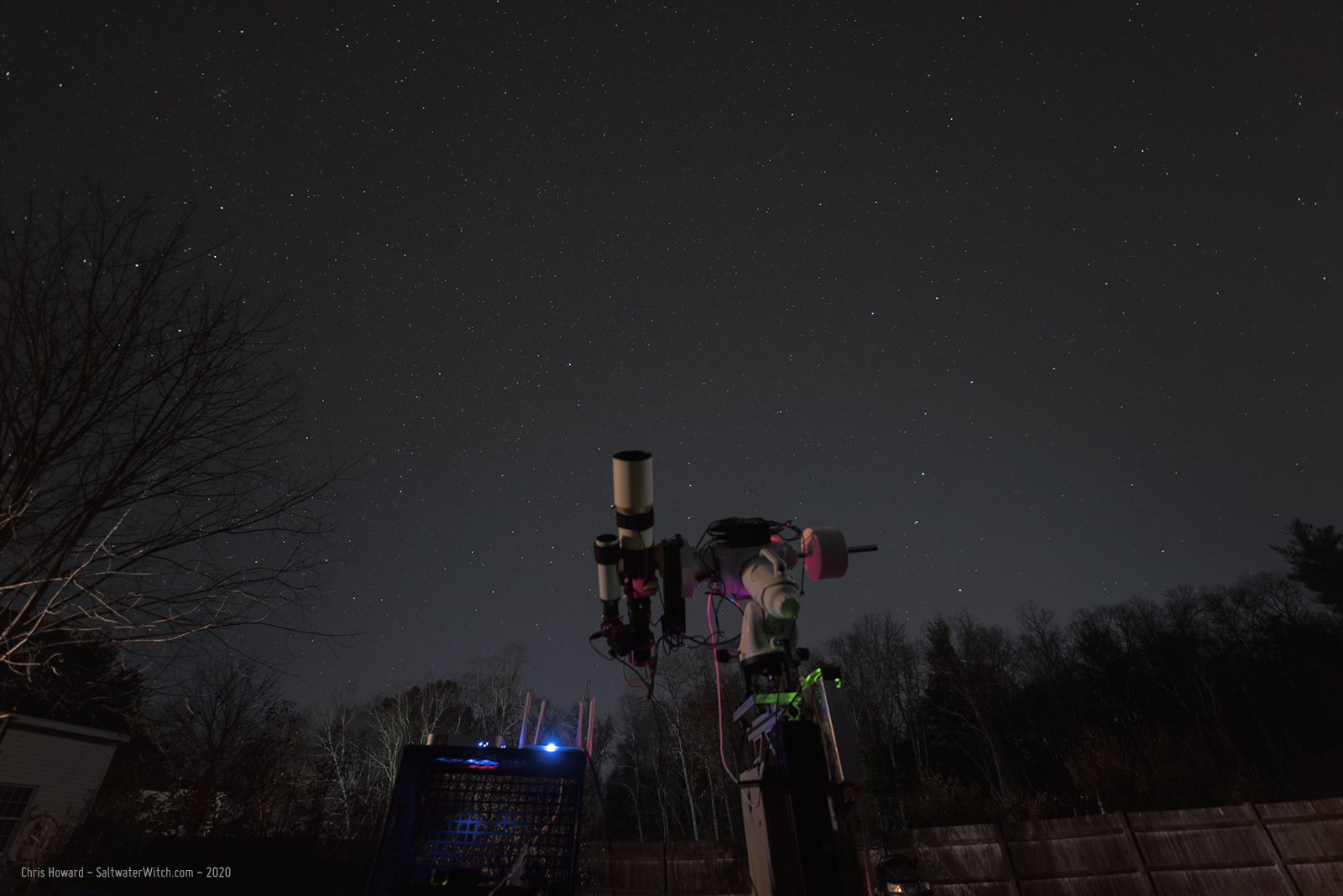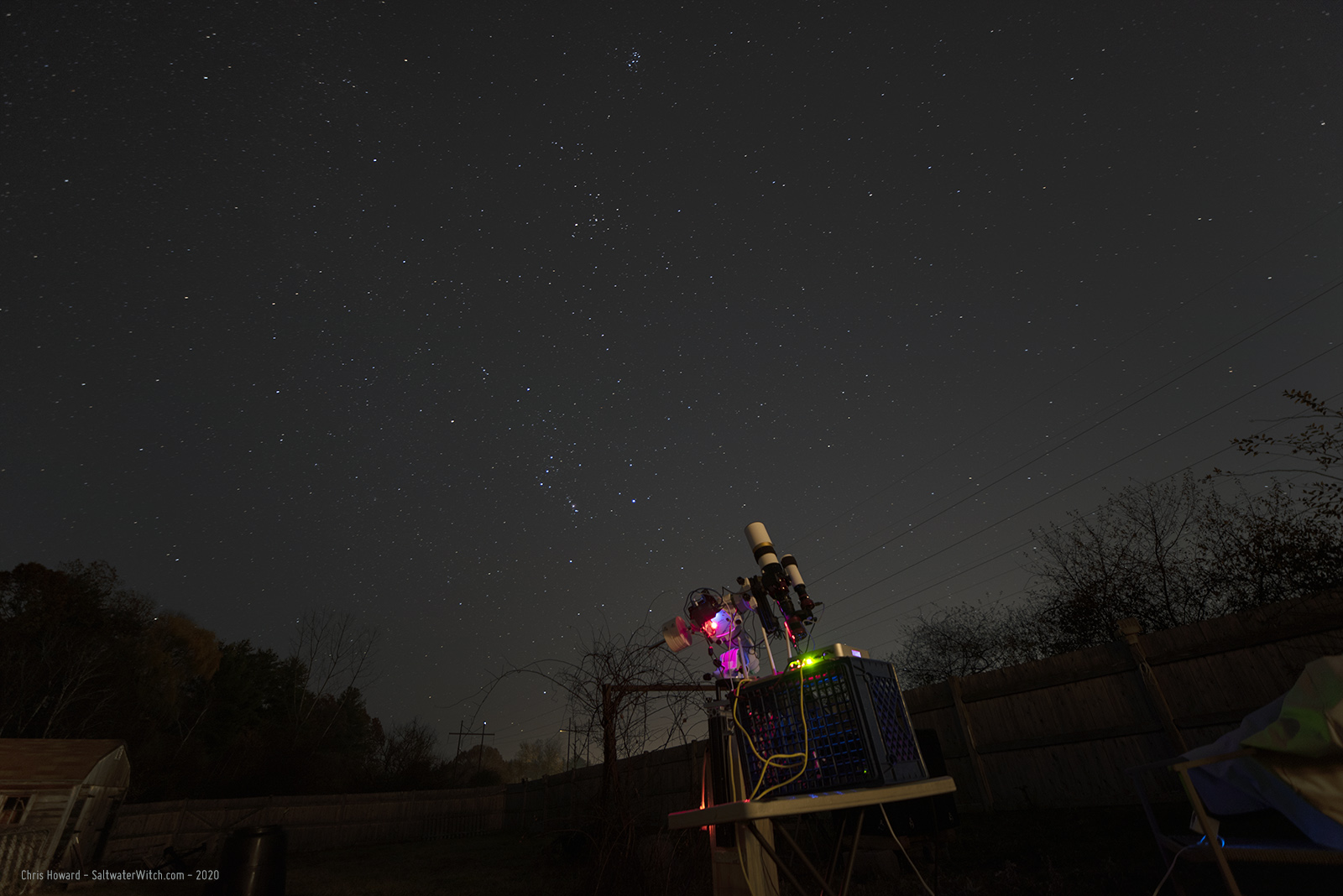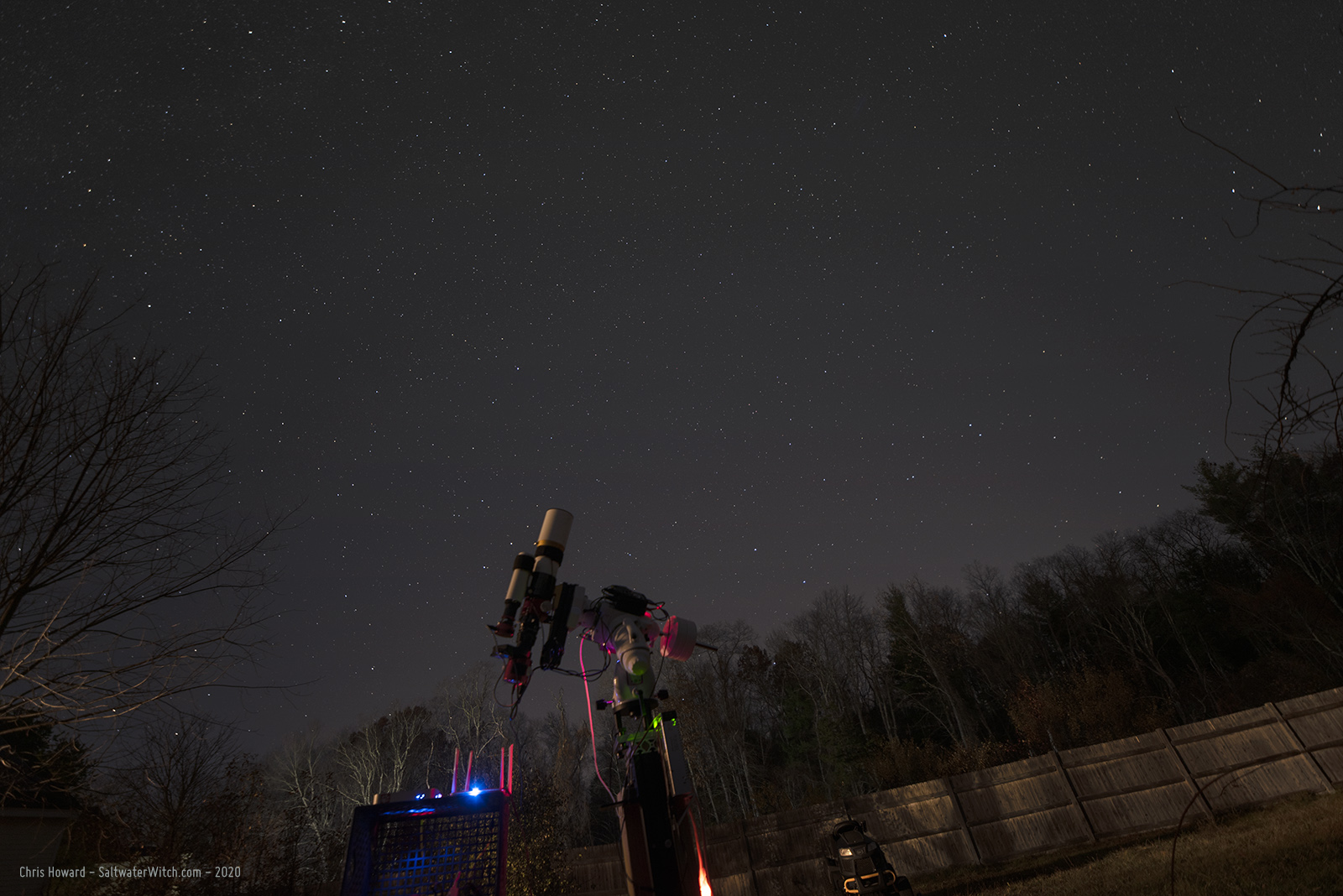Coathanger Cluster and Dark Nebulae
That's why our galaxy is called the Milky Way. The starfield is so dense along the galactic plane, especially as you move toward the core, that the merged brightness of stars is all you see. This is a shot of the "coathanger" cluster--that's the four stars making a hook in the center with the line of stars running underneath (Al Sufi's Cluster, Brocchi's Cluster, Cr 399). The dark clouds in this frame are just that, massive clouds of interstellar dust, molecular hydrogen, and other debris that swirls around our galaxy between the stars--especially between us and these stars--because that's pretty much everything else. It's dust and stars. There are hundreds of billions of stars in the Milky Way and as you look toward the center, you are looking through a hundred-thousand lightyears of the stellar disk--everything that orbits in the galaxy with us. We're 27,000 lightyears out from the core, so you are looking through that as well as everything orbiting on the other side of the core. Yup, it's a bunch of stars, as many as 400 billion just in our galaxy.
I will admit to not being a star cluster guy. Some of them are absolutely fascinating, but they're just not my thing. You show me some dark nebulae, anything from the Barnard Catalog or Lynd's Dark Nebula Catalog, and I'm there. There are a few stand-out dark nebulae below this frame to the right (LDN 770, 778), but there are a batch in this frame including LDN 740, and lower left LDN 741, 745.
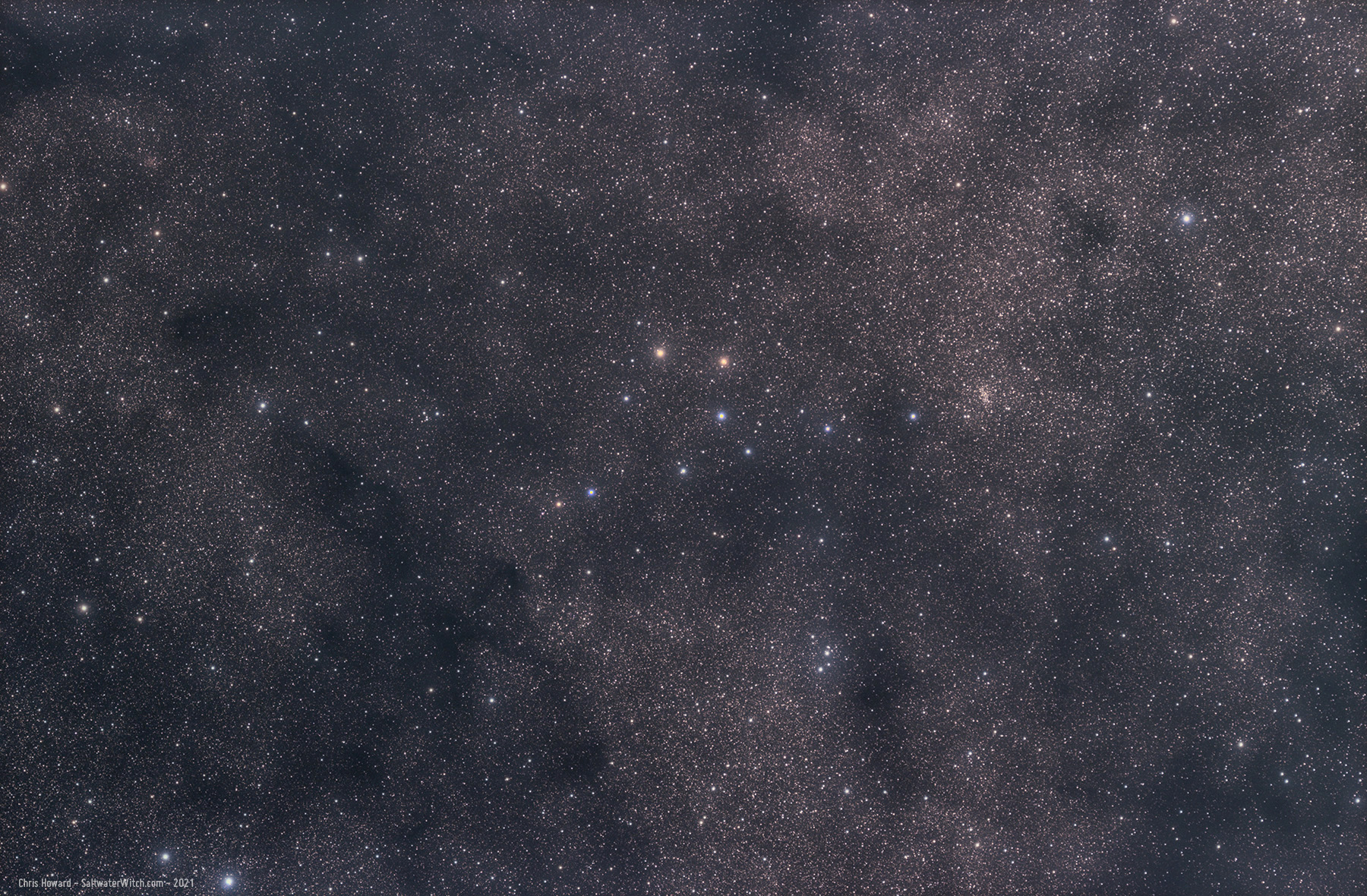
Notes: This is 81 x 60-second sub-exposures stacked in DSS and processed in PS2021. Equipment: William Optics SpaceCat 51 APO refractor, ZWO ASI071MC, no filters, DeepSkyDad AF3 focuser, iOptron CEM25P mount.
Posted May 16, 2021
The cool things you catch while testing
I haven't used the color rig this season, and I was capturing batches of subframes across the sky, mainly to test out focusing. I polar-aligned reasonably well, but didn't guide with these subs. I came away with a bunch of starfield shots, and stacked a couple batches.
The first is the massive blue-white B-type star in the center is Gamma Lyrae or Sulafat from the Arabic السلحفاة al-sulḥafāt "turtle", 漸台三 Jiāntāisān in Chinese astronomy, meaning the Third Star of Clepsydra Terrace. Sulafat is 15 times the sun's size, a little over 600 lightyears away, and it's burning brightly through its main sequence and out the other side.
What's cool is if you right-click this image, open in a new tab, and expand to full size, you can see M57, the Ring Nebula, is there in color middle top of the image.
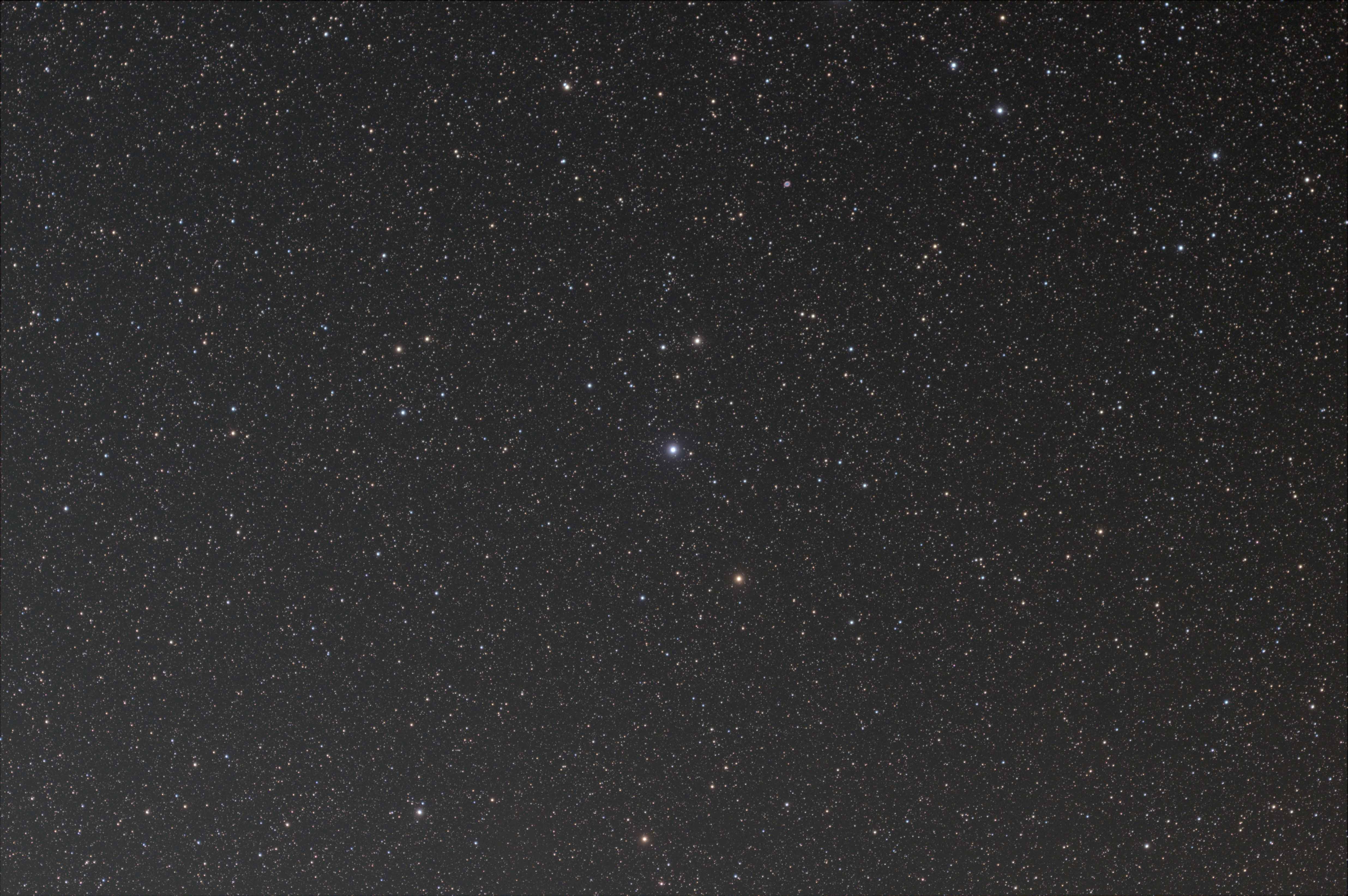
For this set of subs I centered on NGC 5746, the tiny sliver of a barred spiral galaxy in the center. The bright star below it is 109 Virginis in the constellation Virgo. What's crazy about this shot it there at least twenty other galaxies in this frame--probably a lot more that just show up as pinpoints of light.
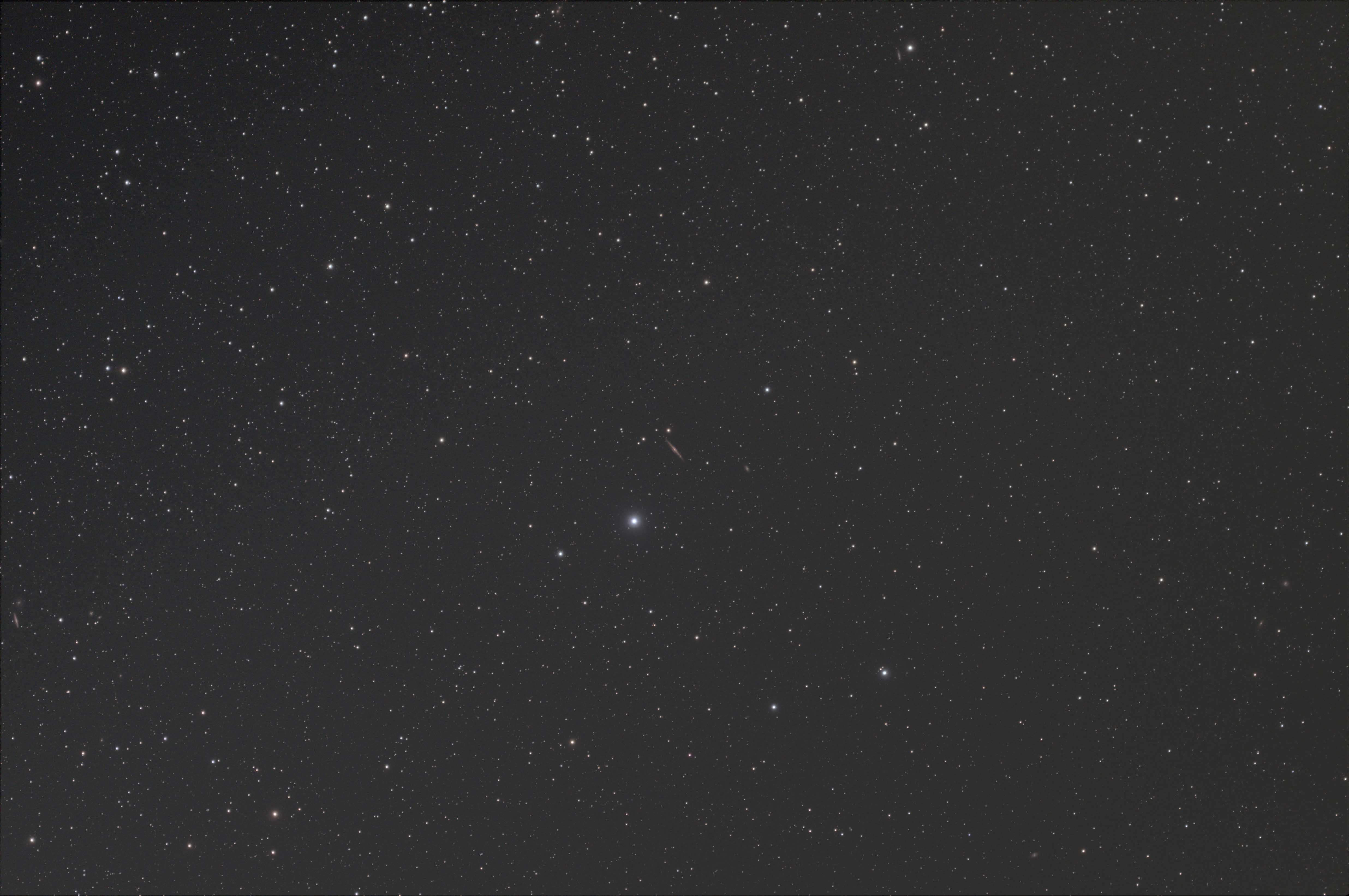
Posted May 14, 2021
So, How's the New Backyard Pier Going?
 That's the big question. Over the last couple weeks I have had five clear nights of imaging with the new pier—the pier allows me to keep my astro gear setup semi-permanently. I park the scope at the end of the night, shut everything down, throw the cover over it and cinch it up. Done. (I bought a TeleGizmos 365 Series Cover for 8-10" SCT from OPT several months back, but I'm just starting to use it now). There were three rainy days between these image captures, and a couple nights that dipped below zero (low 20°s F/ -6C). I left the mount and scope set up in the rain, protected by the cover, and with a couple bags of desiccant, the equipment was completely dry. Unlike a tripod, the pier allows me to tighten the cover around the post under all the equipment, holding off any moisture that might rise up from wet grass and ground.
That's the big question. Over the last couple weeks I have had five clear nights of imaging with the new pier—the pier allows me to keep my astro gear setup semi-permanently. I park the scope at the end of the night, shut everything down, throw the cover over it and cinch it up. Done. (I bought a TeleGizmos 365 Series Cover for 8-10" SCT from OPT several months back, but I'm just starting to use it now). There were three rainy days between these image captures, and a couple nights that dipped below zero (low 20°s F/ -6C). I left the mount and scope set up in the rain, protected by the cover, and with a couple bags of desiccant, the equipment was completely dry. Unlike a tripod, the pier allows me to tighten the cover around the post under all the equipment, holding off any moisture that might rise up from wet grass and ground.
So, how's the pier functioning? Perfectly. My goal was to be able to setup my gear and leave it outside for long periods—maybe weeks, and not have to polar align after the first night. I did run through a polar align the second night because I wanted to see how well it maintained alignment, and it was right on. I have now gone through three more imaging sessions without polar aligning! I simply check the weather, pull off the cover, power up everything, and begin my first sequence of the night. It really has been that simple.
 How is the Total RMS when guiding? Very good—what I expected. Depending on seeing and other factors I've been running with .5" to right around 1", which is as good as it gets for my skies and mount. The pier is rock solid. We'll see how four bolted together lengths of treated lumber behave over time, but I am not expecting any movement.
How is the Total RMS when guiding? Very good—what I expected. Depending on seeing and other factors I've been running with .5" to right around 1", which is as good as it gets for my skies and mount. The pier is rock solid. We'll see how four bolted together lengths of treated lumber behave over time, but I am not expecting any movement.
The distance from the reducer/flattener to the sensor is just a hair too far, maybe a millimeter off, so stars are slightly wonky. I'm still playing around with a few equipment details. Other than that, I'm really happy with these imaging runs. Start-up and shut down is so easy. This really is the next best thing to a backyard observatory. And building the walls and roll-off roof of a tiny observatory around the pier might be a next step, who knows? I also have my micro-observatory project still underway, but that only works with a small mount. I'm having an issue right now with the CEM25P, and I have to resolve that before I can get back to the micro project. At the end of the day, what's cooler than having a permanent astro setup in the backyard? Yup, two permanent astro setups in the backyard.
I went with Hydrogen-alpha for last night's run, and targets included with 60 x 240sec subs of IC 405 (Flaming Star Nebula) in Auriga, and 60 x 240sec subs of IC 2177 and NGC 2327 (Seagull Nebula) in Canis Major.
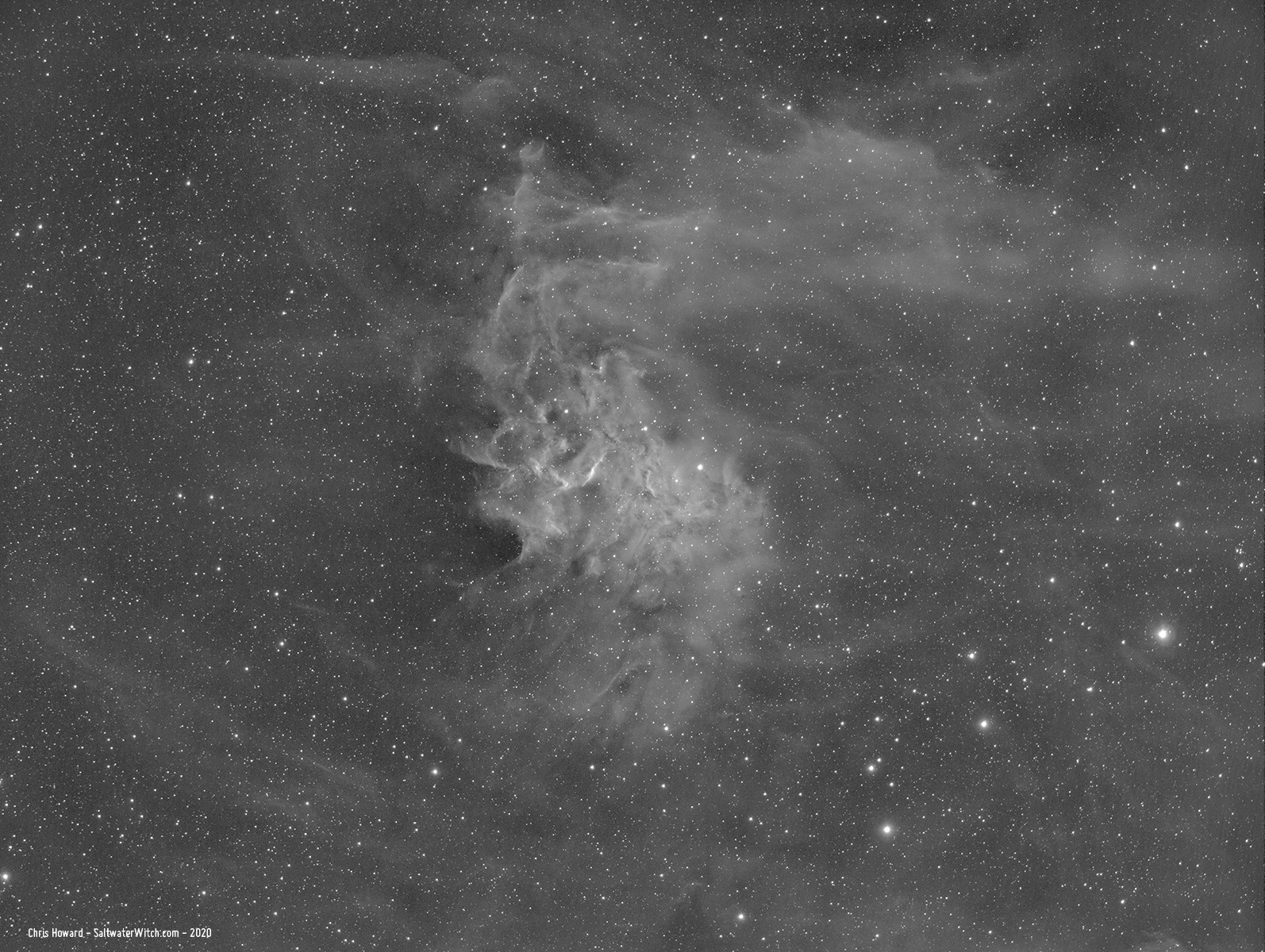
IC 2177, NGC 2327—Seagull Nebula:

Gear notes: SkyWatcher EQ6-R Pro mount, William Optics GT81 Apochromatic Refractor 392mm at f/4.7, ZWO ASI1600MM-Pro monochrome camera, Astronomik 6nm filters, Moonlite focuser, Raspberry Pi 4 4GB / 128GB running INDI/KStars/Ekos
Posted November 19, 2020
M81 and M82
After the earth rotates Orion and Monoceros out of view in the south, I'm only left with a few nebulae. There are a bunch of galaxies though... But with the scope I'm using for large deep sky objects (William Optics GT81 with 392mm focal length), most are too small. M81 (Bode's Galaxy) and M82 (Cigar Galaxy) however, are just large enough to capture. This shot is made up of 30 x 60-second subs in Hydrogen-alpha, Green, and Blue filters that I've mapped to RGB. With the Ha filter you lose some of that broadband Red light, but the trade-off (better IMO) is you capture any large H2 regions in the galaxies. Those are the red and pink chunky bits in Bode's Galaxy and a lot more of that "starburst" core of the Cigar Galaxy—so, basically I'm capturing nebulae in someone else's galaxy, almost 12 million lightyears away from us. Cool. Both of these Messier Objects are in the Constellation Ursa Major (Big Dipper). Gear notes: SkyWatcher EQ6-R Pro mount, William Optics GT81 Apochromatic Refractor 392mm at f/4.7, ZWO ASI1600MM-Pro monochrome camera, Astronomik 6nm filters, Moonlite focuser, Raspberry Pi 4 4GB / 128GB running INDI/KStars/Ekos

Posted November 17, 2020
Rosette Nebula and Surrounding Region
From the imaging run last night. The Rosette Nebula (NGC 2237) in the Constellation Monoceros is another deep sky object I typically capture every year--at least once! Trailing Orion across the sky, it's over a 100 light-years across and about 5000 lightyears away from us. 50 x 240 second sub-exposures in Ha. Gear notes: SkyWatcher EQ6-R Pro mount, William Optics GT81 Apochromatic Refractor 392mm at f/4.7, ZWO ASI1600MM-Pro monochrome camera, Astronomik 6nm filters, Moonlite focuser, Raspberry Pi 4 4GB / 128GB running INDI/KStars/Ekos

Rosette Nebula in the Constellation Monoceros (detail). You're looking at about 360 trillion miles of globules and globulettes—all those dark cloudy bits, running from the bottom middle of this frame to the top right. This is a detail view of my last Hydrogen-alpha image of NGC 2237 where interstellar gas and dust around one side of the Rosette Nebula have condensed into strings of dark cloudlets that block the emission from the core group of stars lighting up the broader background. Several of the stars that make up the cluster NGC 2244 are massive super-hot O-type stars, and these produce the stellar winds and intense radiation that have shaped the Rosette Nebula. To give you a sense of the scale here, pick any of the branches in those dark cloudy structures, or even most of the loose globules of condensing hydrogen. Our entire solar system can easily fit within the width of one of these. And I'm not talking about the orbit of Pluto; I'm using the Oort Cloud as the defining boundary, which would make the diameter of our solar system roughly 1.5 lightyears. In other words you can fit about 240 of our solar systems, lined up one after the other, in the same space as this chain of dark clouds. William Optics GT81 @f/4.7 Astronomik 6nm Ha filter, ZWO ASI1600MM-Pro mono camera.

Posted November 15, 2020
California Nebula in Ha + SII
Tuesday night I captured 50 x 4-minute sub-exposures in Hydrogen-alpha for NGC 1499 (California Nebula) and last night I captured 60 x 240 second exposures in Sulfur 2 (SII), combining them here into a color image, with Ha in red, SII in blue, and each shared equally across the green channel of an RGB image. There just isn't any OIII (Oxygen) in the mix for this massive emission nebula in the Constellation Perseus. Gear notes: SkyWatcher EQ6-R Pro mount, William Optics GT81 Apochromatic Refractor 392mm at f/4.7, ZWO ASI1600MM-Pro monochrome camera, Astronomik 6nm filters, Raspberry Pi 4 4GB / 128GB running INDI/KStars/Ekos

Posted November 15, 2020
A Night in the Life of an Astrophotographer
Posted November 10, 2020
Astro Session November 11, 2020
Wow, we actually have a pretty decent view of the universe from our backyard. Notes: Nikon D750, Irix 15mm f/2.4, 30-second exposures. That's Ursa Major, the Big Dipper, to the right of the scope, that upside down W in the tree branches is Cassiopeia, and that bright star between them, a little to the left of where the scope is pointing, is Polaris, the North Star.
